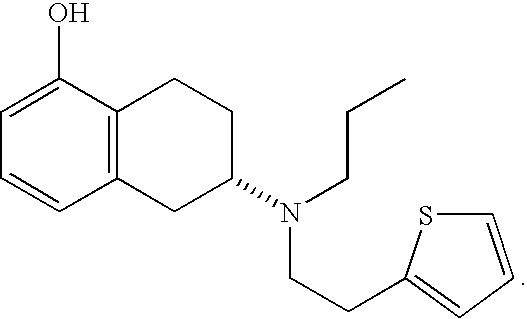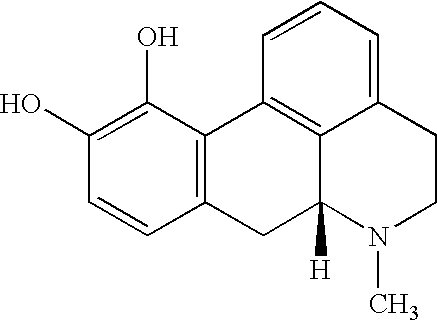Iontophoretic delivery of rotigotine for the treatment of Parkinson's disease
- Summary
- Abstract
- Description
- Claims
- Application Information
AI Technical Summary
Benefits of technology
Problems solved by technology
Method used
Image
Examples
example 2
[0039]Using a similar procedure as in Example 1 and a concentration of rotigotine of 1.4 mg / ml (3.98 mM), a pH in the donor chamber of 5, a current density of 500 μA / cm2, a pH in the acceptor chamber of 7.4 and a temperature of 20° C., but substituting triethylammonium chloride (TEACl) or tributylammonium chloride (TBACl) for NaCl, the influence of the different cations on the flux was evaluated. The concentration of the chloride salts in the donor solution was 70 mmol / l.
[0040]
Flux (nmol / cm2 / h)Co-ions sourceRotigotineNaCl53.2TEACl72.8TBACl62.0
example 3
[0041]Using a similar procedure and the same parameters as in Example 2, the influence of reducing the pH in the acceptor chamber from 7.4 to 6.2 was evaluated for different chloride salts. The concentration of the chloride salts in the donor solution was 70 mmol / l.
[0042]
Flux (nmol / cm2 / h)Co-ions sourceRotigotineNaCl58.9TEACl43.2TBACl76.5
PUM
| Property | Measurement | Unit |
|---|---|---|
| Concentration | aaaaa | aaaaa |
| Concentration | aaaaa | aaaaa |
| Molar density | aaaaa | aaaaa |
Abstract
Description
Claims
Application Information
 Login to View More
Login to View More - R&D
- Intellectual Property
- Life Sciences
- Materials
- Tech Scout
- Unparalleled Data Quality
- Higher Quality Content
- 60% Fewer Hallucinations
Browse by: Latest US Patents, China's latest patents, Technical Efficacy Thesaurus, Application Domain, Technology Topic, Popular Technical Reports.
© 2025 PatSnap. All rights reserved.Legal|Privacy policy|Modern Slavery Act Transparency Statement|Sitemap|About US| Contact US: help@patsnap.com



